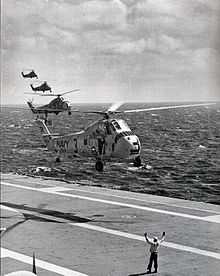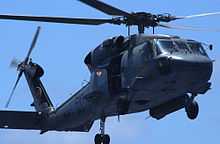HS-4
| Helicopter Sea Combat Squadron Four (HSC-4) | |
|---|---|
.jpg) HSC-4 Insignia | |
| Active | 30 June 1952 - present |
| Country |
|
| Branch |
|
| Type | helicopter anti-submarine squadron |
| Part of | active |
| Garrison/HQ | NAS North Island |
| Nickname | Black Knights |
Helicopter Sea Combat Squadron 4 (HSC-4) is a helicopter squadron of the United States Navy established in 1952 as Helicopter Anti-Submarine Squadron 4 (HS-4). HS-4 was commissioned on 30 June 1952 at U.S. Naval Auxiliary Landing Field, Imperial Beach, California, equipped with the Sikorsky HO4S-3. On 29 March 2012, HS-4 was recomissioned as HSC-4.
History
1952–1968
HS-4 was the first anti-submarine warfare (ASW) helicopter squadron of the U.S. Navy to deploy aboard an aircraft carrier, the escort carrier Rendova (CVE-114). In 1954/55 HS-4 was deployed on the Essex-class aircraft carrier Princeton (CV-37). Afterwards the squadron converted to the Sikorsky HSS-1 Seabat helicopter and first deployed aboard the Boxer (CV-21) in 1956. This was followed by a cruise aboard the Princeton again in 1958. HS-4 could be identified at that time by the tail code "TA" (1955-1960). In 1961, it became the first ASW squadron in Commander Naval Air Forces Pacific (COMNAVAIRPAC) to achieve around-the-clock ASW capability, earning HS-4 the title "Black Knights".




From 1960 to 1968 HS-4 made six deployments aboard the Yorktown (CV-10) to the Western Pacific as part of Carrier Anti-Submarine Air Group 55 (CVSG-55) (tail code "NU"). In 1964 the squadron converted to the Sikorsky SH-3A Sea King. HS-4 was initiated into combat during its 1966 cruise to Southeast Asia. While operating in the Gulf of Tonkin, HS-4 pilots and aircrew rescued 24 downed airmen under hostile fire, a record for an ASW squadron in a single deployment. In 1968 HS-4 aboard Yorktown was part of the Task Force sent to the Sea of Japan at the beginning of the USS Pueblo incident.
1968–1990
From 1968 to 1970 HS-4 was assigned to Carrier Anti-Submarine Air Group 59 (CVSG-59) (tail code "NT") aboard the Hornet. From late 1968 through the spring of 1970, the Black Knights of HS-4 participated in and pioneered techniques for the Apollo capsule recoveries. HS-4 was on scene for Apollo missions 8, 10, 11, 12, and 13. The recovery was always made by "Helicopter 66". The helicopter's flight number was changed from "66" to "740", as after the Apollo 11 recovery the U.S. Navy had switched to a three number squadron designator - but the helicopter was repainted with the number "66" for each recovery thereafter for public relations reasons. HS-4 earned a Meritorious Unit Commendation (MUC) for these recoveries. For the recovery of Apollo 13 in April 1970, HS-4 was assigned to the helicopter carrier Iwo Jima (LPH-2).
In 1971 HS-4 was deployed for the last time on an anti-submarine carrier, the Ticonderoga (CV-14). In 1973/74 the "Black Knights" were aboard the Kitty Hawk (CV-63) during a cruise to the Western Pacific where they helped to develop the CV concept, which integrated the former "Anti-Submarine Air Group" and "Attack Carrier Air Wing" into the new "Carrier Air Wing". For this deployment HS-4 was assigned to Carrier Air Wing 11 (CVW-11). Between 1976 and 1979 HS-4 made two cruises aboard the Ranger (CV-61) as part of Carrier Air Wing 2 (CVW-2), before being reassigned to Carrier Air Wing 15 (CVW-15). The first deployment was made aboard the Kitty Hawk, followed by seven cruises aboard the Carl Vinson (CVN-70) between 1983 and 1990.
HS-4 had numerous awards since its inception: seven-time winner of the Chief of Naval Operations Aviation Safety Award, Arleigh Burke Fleet trophy in 1978, five-time winner of the Battle 'E' (Battle Efficiency), three-time winner of the Captain Arnold J. Tobell trophy for ASW excellence and the Sikorsky 'Excellence in Maintenance' Award for 1979, 1982 and 1983.
1991–2006
In 1991, HS-4 transitioned from the SH-3H Sea King to the Sikorsky SH-60F and HH-60H helicopters and returned to the USS Kitty Hawk as part of CVW-15 for three deployments between 1991 and 1994. They supported Operations Restore Hope and Southern Watch in 1994, and supported the carrier battle group during Korean contingency operations with detachments to both Korea and Japan.
When CVW-15 was deactivated, HS-4 was reassigned to CVW-14 in January 1995. In 1996 HS-4 made a single deployment aboard the Carl Vinson before CVW-14 and the Black Knights were assigned to the Abraham Lincoln (CVN-72) from 1998 to 2003. Their duties included military operations in Pakistan, detachments in Kuwait and combat search and rescue training in Australia, all in support of "Operation Southern Watch" and Operation Enduring Freedom. During Operation Iraqi Freedom, HS-4 supported Navy SEAL, British Commando and Polish GROM forces in Kuwait and Iraq. HS-4 was awarded the Sikorsky Maintenance and Battle “E” maintenance awards for excellence and achieved the retention honor roll. The nine and one half month deployment (a record since the Second World War) included 1283 sorties and 3228 flight hours flown.
In 2004, HS-4 and CVW-14 were reassigned to the John C. Stennis (CVN-74). On board the Stennis, HS-4 completed a cruise to the Western Pacific, which took the squadron from San Diego, to Alaska, Victoria, British Columbia, Canada, Japan, Malaysia and Australia. In 2006 HS-4 and CVW-14 transferred to the Ronald Reagan (CVN-76) for her maiden deployment. On this deployment HS-4 detached its HH-60Hs into Basra, Iraq to support coalition troops in the region.
See also
|
References
External links
| |||||||||||||||||||||||||||||||||||||||||||||||||||||||||
